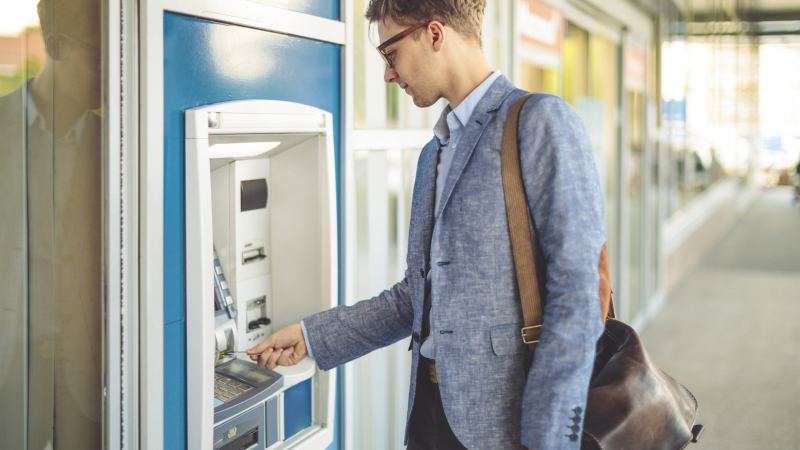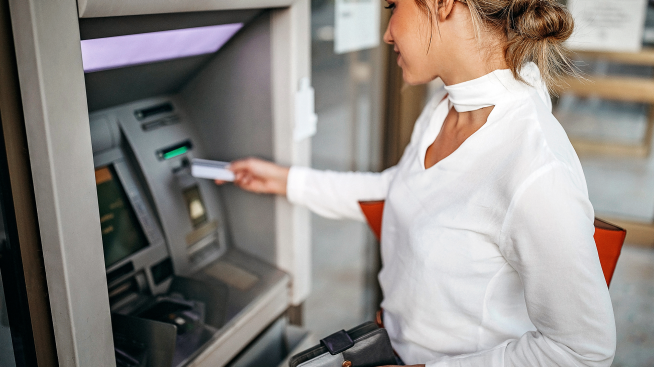What is an ATM withdrawal limit?

An ATM withdrawal limit restricts the amount that a bank or credit union allows for withdrawal from an ATM. While this withdrawal limit might sometimes feel like a nuisance, it can be helpful when you are trying to manage your spending. As helpful as these functions are, sometimes you may need access to more cash - be it for emergencies or for other last-minute spending. Let's learn a little more about how ATM withdrawal limits work.
How ATM withdrawal limits work
ATM cash withdrawals may be limited in a couple of ways. Banks might keep a cap on the total amount per day, limit withdrawal amounts per transaction, or both. Additionally, some savings accounts may come with monthly withdrawal limits of their own, to which ATM withdrawals may contribute. Be sure to speak with your bank regarding their savings account withdrawal policy.
The specifics of ATM withdrawal limits vary from bank to bank and can be affected by other factors like your account type. Contact your bank to find out more about the withdrawal limits associated with your account.
Purchase limits vs. ATM withdrawal limits
Do debit cards have limits? Indeed, there may also be daily purchase limits on your debit cards — separate from the ATM withdrawal limit. These purchase limits are often higher than the caps on ATM cash withdrawals, though some banks may also maintain a third limit on total spending per day that’s cumulative of both. Familiarizing yourself with these two limits can help plan your purchases accordingly.
How to find your ATM withdrawal limit
The documents provided to you at account opening and with your debit card usually include your ATM withdrawal limit. Alternatively, your ATM withdrawal limit may be mentioned inside your bank’s official banking app, should it have one. If neither are available, calling your bank can help clarify your individual ATM withdrawal limit.
Why do ATMs have withdrawal limits?
Though they may feel like an inconvenience at first, these limits can help in two important ways. The first is they may improve security; banks keep maximum ATM withdrawal limits in place to help protect your funds. Should a thief gain access to your card and debit card PIN, without a daily or transactional withdrawal limit, they could rapidly drain your accounts.
Secondly, ATMs can only carry so much cash. There are few things more inconvenient than needing cash, finding an ATM, and discovering its empty. Limiting the amount of cash that can be withdrawn per customer helps to ensure cash remains available for other customers.
How to avoid ATM withdrawal limits
Though in place for good reason, you may find yourself in need of more cash than these limits might allow. Fortunately, for things like emergency spending or last-minute funding, you have several options to consider.
Increasing ATM withdrawal limits
Some banks may allow you to request a temporary or permanent increase in your ATM withdrawal limit. Those about to go on vacation, for example, or whose job requires a lot of cash spending, may consider requesting temporary or permanent increases in ATM withdrawal limits based on their needs. Honoring this type of request is often discretionary and determined on a case-by-case basis by the bank.
Making in-person withdrawals from your checking account
If you’ve hit your limit but need more cash, you may be able to make an in-person withdrawal at your bank’s nearest branch. After all, ATM is short for automated teller machine; when these machines fall short, seeing an actual teller might get you the cash you need.
Writing checks to cash
Similar to an in-person ATM withdrawal, you could always write yourself a check to cash. This is a roundabout way to withdraw cash but can help you sidestep your ATM withdrawal limit in a pinch. Note that there may be another limit on the number of checks you can cash per day or amount you can cash per check.
Withdrawing from a savings account
If you have a savings account, you may be able to withdrawal funds from it if you've already reached your daily withdrawal limit from your checking account. It's important to remember that some banks have monthly withdrawal limits on savings accounts and that ATM withdrawals may contribute to this limit.
Getting cash back on purchases
Nowadays, many stores offer cash back on debit card purchases, allowing you to essentially "withdraw" from the register by adding the cash back amount to your bill. This alternative can be handy when you need quick cash, but the limits on the cash-back amount are typically much lower than the standard ATM withdrawal limits and are usually decided by the merchant. Cash back requires a transaction at the store and will contribute to your purchase limit - and potentially your daily withdrawal limit too. Ask your bank if there are any fees associated with a cash back transaction.
In summary
ATM withdrawal limits are in place to help restrict the amount that a bank or credit union allows for withdrawal from an ATM and may improve cash availability. But sometimes you may need access to more cash for emergencies or last minute spending. In-person withdrawals, accessing savings, writing checks to yourself and in-store cash back may be options to access more of your funds when necessary. If you find yourself regularly hitting your limit or foresee needing a higher limit soon, your bank may be willing to provide a temporary or permanent increase in your personal ATM withdrawal limit. Reaching out and speaking with your bank can shine a light on the specifics of your individual limits and what your options for increasing it may be.



